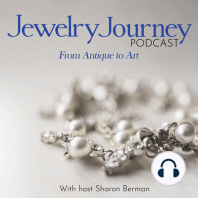28 min listen

Episode 174 Part 2: What’s Next in Artist-Jeweler William Harper’s 50+ Year Career
Episode 174 Part 2: What’s Next in Artist-Jeweler William Harper’s 50+ Year Career
ratings:
Length:
26 minutes
Released:
Nov 30, 2022
Format:
Podcast episode
Description
What you’ll learn in this episode: How synesthesia—the ability to hear colors and see music—has impacted William’s work Inside William’s creative process, and why he never uses sketches or finishes a piece in one sitting Why jewelry artists should never scrap a piece, even if they don’t like it in the moment The benefits of being a self-taught artist, and why art teachers should never aim to impart their style onto their students How a wearer’s body becomes like a gallery wall for jewelry About William Harper Born in Ohio and currently working in New York City, William Harper is considered one of the most significant jewelers of the 20th century. After studying advanced enameling techniques at the Cleveland Institute of Art, Harper began his career as an abstract painter but transitioned to enameling and studio craft jewelry in the 1960s. He is known for creating esoteric works rooted in mythology and art history, often using unexpected objects such as bone, nails, and plastic beads in addition to traditional enamel, pearls, and precious metals and stones. His work is in the collections of the Metropolitan Museum of Art, the American Museum of Crafts, the Cleveland Museum of Art, and the Museum of Fine Arts, Boston. A retrospective of his work, William Harper: The Beautiful & the Grotesque, was exhibited at the Cleveland Institute of Art in 2019. Additional Resources: William's Instagram Photos available on TheJewelryJourney.com Transcript: Rather than stifle his creativity, the constraints of quarantine lockdown and physical health issues helped artist-jeweler William Harper create a series of intricate jewels and paintings imbued with meaning. After 50+ years as an enamellist, educator and artist in a variety of media, he continues to find new ways to capture and share his ideas. He joined the Jewelry Journey Podcast to talk about his creative process; why he didn’t want his art students to copy his style; and why he never throws a piece in progress away, even if he doesn’t like it. Read the episode transcript here. Sharon: Hello, everyone. Welcome to the Jewelry Journey Podcast. This is the second part of a two-part episode. If you haven’t heard part one, please head to TheJewelryJourney.com. I’d like to welcome back one of today’s foremost jewelers, William Harper. To say he is a jeweler leaves out many parts of him. He’s a sculptor, an educator, an artist, an enamellist, and I’m sure I’m leaving out a lot more. Welcome back. Yes. Is that how you got to the collection you did during lockdown quarantine? William: Yes. I live in New York, and New York had almost a complete shutdown. My husband and I were afraid we were going to come down with a disease if we intermingled with too many people. We essentially were in lockdown or quarantine for several months. In that period, I decided I wanted to do something absolutely different from anything I had done before, and I wanted it to be politically motivated. So, just as Goya or Manet or Picasso did important paintings based on criticizing a political body—in Guernica, for instance, Picasso was painting the disruption of the small town of Guernica in Spain. Very powerful. I wanted to see if I could do that in jewelry, which was really strange, I have to say. I had been playing for at least a year with the idea of trying to do a piece inspired by the expression “the tainted fruit of the poisoned tree.” That’s an obtuse way of approaching a piece of jewelry, but I thought of it in terms of the bottom of the tree, the poisoned tree, was our ex-president. At the top, there were elements that represented his monstrous children. You see my politics right there. It’s a beautiful piece. If you know the substance behind it, it will mean more to you, but you don’t have to. I wanted each piece to be beautiful. Now, my idea of beauty can be unlike a lot of people’s, but I think an artist has to know his guidelines for what he wants to be beautiful. There’s nothing wrong with the te
Released:
Nov 30, 2022
Format:
Podcast episode
Titles in the series (100)
Episode 6: Fueling the Appreciation of Art Jewelry, with Patti Bleicher, Co-founder of Gallery Loupe by Jewelry Journey Podcast